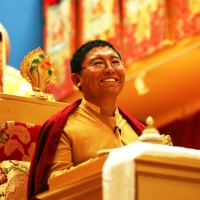What is the difference between the real state of rigpa and the imitation? Check whether or not there is any clinging, any sense of keeping hold of something. With conceptual rigpa you notice a sense of trying to keep a state, trying to maintain a state, trying to nurture a state. There is a sense of hope or fear and also a sense of being occupied. Understand? The keeping means there’s a sense of protecting, of not wanting to lose it, in the back of the mind. This is not bad, it’s good, and for some people there’s no way around training like that in the beginning. Through training in this way, that conceptual aspect becomes increasingly refined and clarified.
So you practice more, more, more. Now you have more of a sense of openness, but still you’re holding this openness. All right, then, let the openness go. Let’s say that after two months you let it go. But still you’re staying within the openness — so then you practice letting go of the staying. And somehow there is still a remnant of wanting to achieve it again. So you let that go as well, and slowly again let it go, let it go, until you become very much “just there,” and finally very free and easy.

Tsoknyi Rinpoche
from the book Fearless Simplicity: The Dzogchen Way of Living Freely in a Complex World
Read a random quote or see all quotes by Tsoknyi Rinpoche.
Further quotes from the book Fearless Simplicity:
- Simply an illusion
- Acknowledging illusion
- True compassion and devotion
- Importance of a calm mind
- Just let it go and relax
- Set your buttocks down and train
- True freedom
- Fearless simplicity
- Expanding compassion